Every kitchen adventure starts with curiosity. When I first found Chinese Squash Recipes kabocha, my cooking changed. This Japanese pumpkin is more than a veggie—it opens doors to vibrant, healthy vegan recipes.
Kabocha Chinese Squash Recipes adds magic to your meals with its sweet, nutty taste and creamy texture. It's a key ingredient in vegan Asian dishes, packed with fiber and low in calories. These recipes will excite your taste buds and support your health.
Imagine turning this squash into eight stunning dishes that honor Chinese cooking traditions. From stir-fries to steamed dishes, each recipe highlights kabocha's amazing qualities. Whether you're a seasoned vegan or new to plant-based cooking, these recipes will inspire and nourish you.Get ready for a tasty journey that connects you with Asian cooking traditions. Your kitchen will become a place of flavor, nutrition, and creativity.
Table of contents
Understanding Kabocha: The Chinese Squash Connection

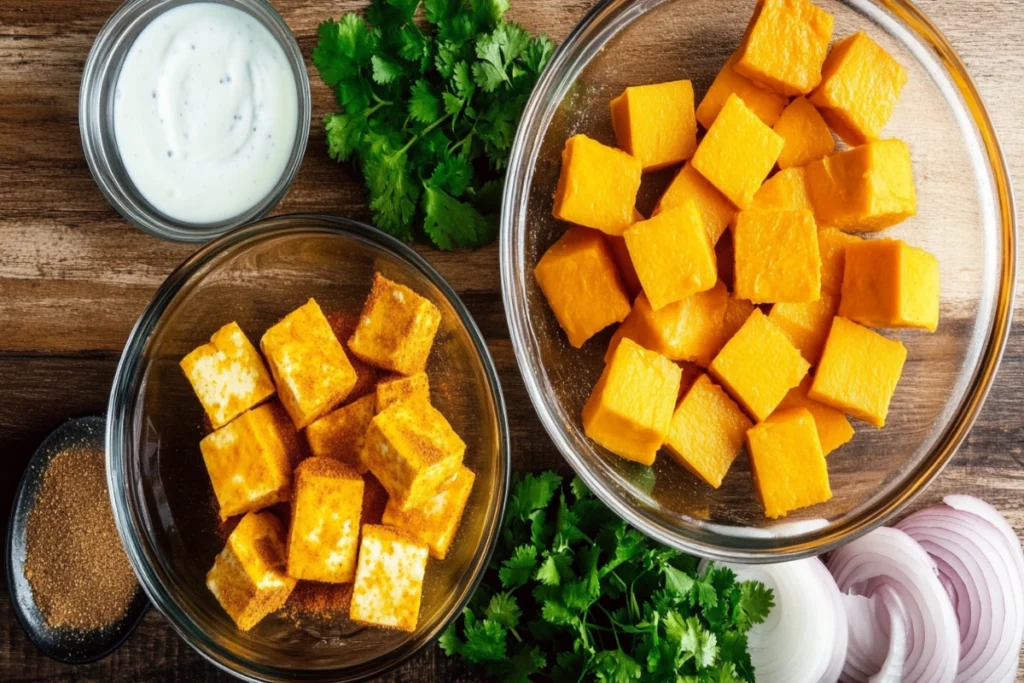
Kabocha squash is a culinary gem from Japan that has won the hearts of many. It adds a special flavor to dishes like easy kabocha chinese squash recipes and plant-based kabocha squash meals.
What Makes Kabocha Unique
The kabocha is special because of its unique traits. Its deep green rind and sweet, chestnut-like flavor make it a favorite in Asian cooking.
- Low calorie content compared to other winter squashes
- Naturally sweet taste reminiscent of chestnuts
- Dense, creamy texture perfect for various cooking methods
Cultural Significance in Chinese Squash Recipes
In Chinese cooking, kabocha squash is a key ingredient. It’s known as “chestnut squash” for its unique taste.
"Kabocha is not just a squash, it's a culinary bridge between Japanese and Chinese cooking traditions."
Seasonal Availability and Selection
When picking the best kabocha, keep these tips in mind:
| Selection Criteria | Details |
|---|---|
| Weight | Choose squash that feels heavy for its size |
| Color | Deep green rind indicates ripeness |
| Storage | Can be kept 2-4 months in cool, dry place |
Pro tip: Kabocha is in season from October to December. It’s great for autumn dishes.
Essential Ingredients and Tools for Chinese Squash Recipes
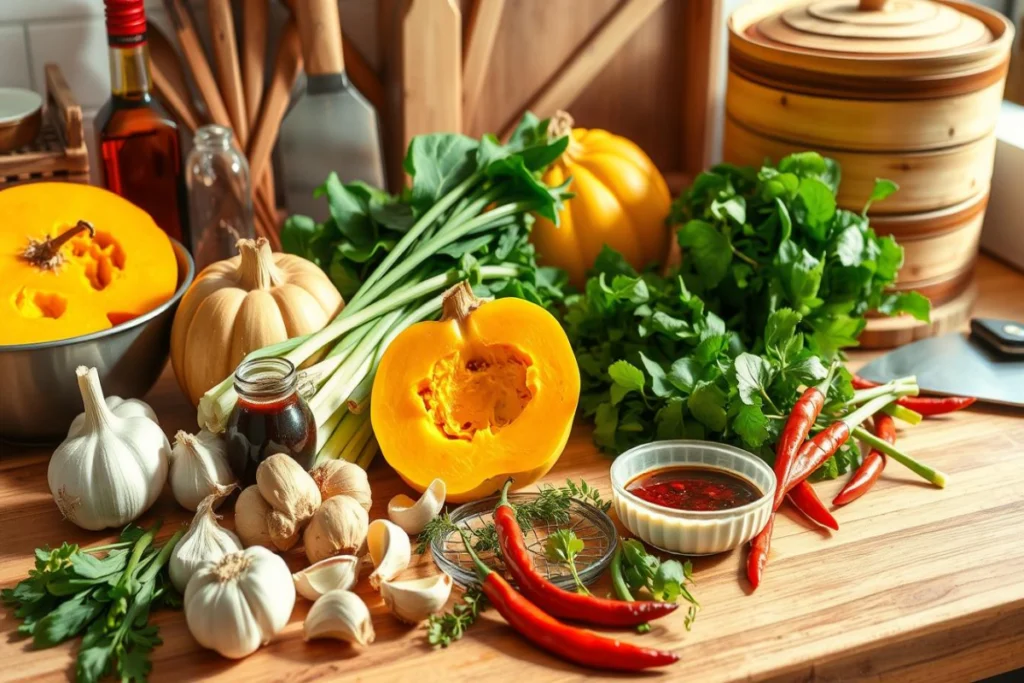
To make authentic Chinese kabocha squash recipes, you need the right ingredients and tools. Your journey into vegan kabocha side dishes begins with knowing the key elements that make these dishes special.
Key Ingredients for Flavor Depth
For amazing Chinese-inspired kabocha dishes, you’ll need certain ingredients:
- Soy sauce for umami richness
- Rice vinegar for tangy brightness
- Sesame oil for nutty undertones
- Fresh ginger for warming spice
- Garlic for aromatic complexity
- Scallions for fresh green notes
Essential Kitchen Tools
For kabocha preparation, you’ll need precise tools for easy and efficient cooking:
- A razor-sharp chef’s knife for safely cutting through thick squash skin
- Sturdy baking sheet for roasting
- Wok or large saucepan for braising
- Cutting board with non-slip surface
"The right tools transform cooking from a chore into an art." - Chef's Wisdom
Adding tahini, lemon juice, and maple syrup can make your vegan kabocha side dishes even better. These ingredients add depth and make your Chinese-inspired kabocha recipes unforgettable.
Health Benefits of Kabocha Squash in Chinese Squash Recipes
Kabocha squash is a nutritional powerhouse for those looking for healthy recipes. This vibrant Japanese pumpkin is full of nutrients. It can make your plant-based meals a wellness-boosting experience.
Explore the amazing nutritional profile of this winter squash. It has just 30 calories per 100g. Kabocha is packed with essential vitamins and minerals that support health.
Vitamin and Mineral Powerhouse
- Contains 9mg of Vitamin C per 100g
- Rich in beta-carotene for eye and skin health
- Provides important B vitamins
- Excellent source of iron and magnesium
Health Benefits for Plant-Based Diets
Kabocha squash is great for plant-based diets. It has 1.2g of fiber per 100g, which is good for digestion. It also helps keep blood sugar levels steady. Plus, it’s a good protein alternative with 1.1g per serving.
"Kabocha squash transforms simple meals into nutritional powerhouses" - Nutrition Experts
Comparing Kabocha to Other Winter Chinese Squash Recipes
Kabocha is different from other winter squashes. It has fewer calories and more nutrients. Its versatility makes it perfect for healthy kabocha squash recipes that are tasty and nutritious.
While kabocha is very healthy, eating too much can cause carotenemia. This is a condition that makes your skin turn yellow or orange.
Preparation Techniques for Chinese-Style Squash Dishes
Learning to make easy Chinese kabocha recipes begins with knowing how to prepare it. Kabocha squash has a bright green or deep orange skin. It needs special care to bring out its sweet, creamy taste for vegan dishes.
Choose a kabocha with a rich color and firm skin. The best ones are heavy for their size and have no soft spots or blemishes.
- Softening Technique: Microwave or oven-warm the squash for 3-5 minutes to make cutting easier
- Cutting Method: Use a sharp chef’s knife and cut carefully through the thick skin
- Seed Removal: Scoop out seeds with a spoon, saving them for roasting if desired
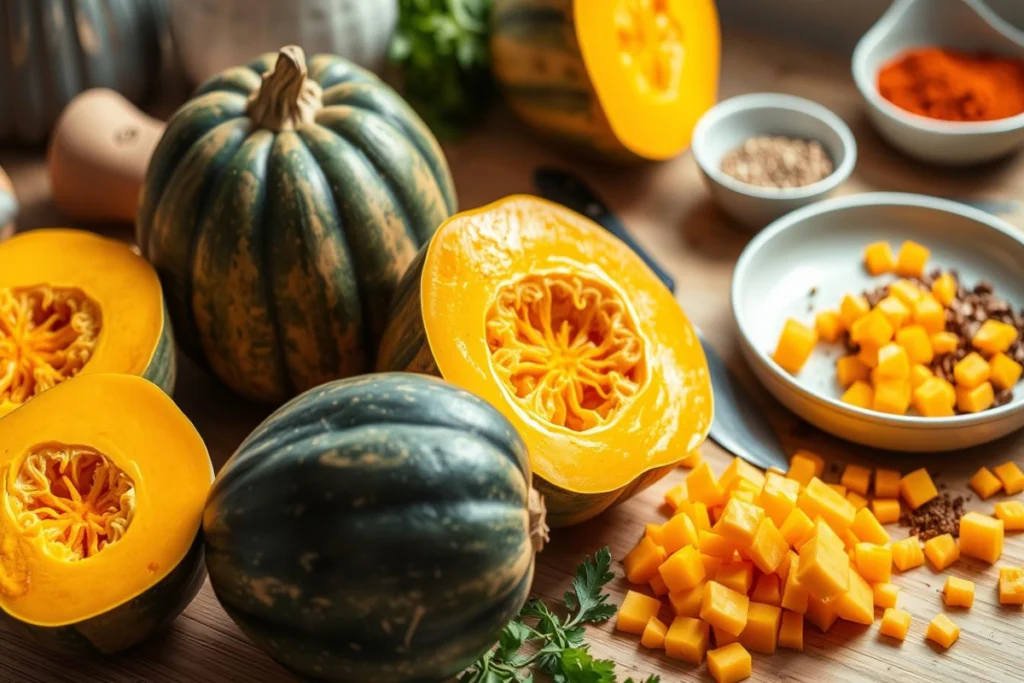
Storing your kabocha right is key to keeping it fresh. You can store uncut squash in a cool, dry place for up to a month. Cut pieces should be refrigerated in an airtight container and used within 5-7 days.
"The secret to perfect kabocha is in the preparation and respect for its unique texture." - Chinese Culinary Experts
For vegan kabocha side dishes, remember the whole squash is edible, including the skin. Just wash it well before cooking to get the most flavor and nutrition.
Chinese Squash Recipes Kabocha Vegan: Step-by-Step Guide
Exploring authentic Chinese kabocha squash recipes is a tasty vegan journey. Kabocha squash is sweet and creamy, perfect for Chinese dishes. These dishes will make your taste buds happy.

Preparing the Perfect Base
To start making great Chinese squash recipes with kabocha, first pick and prepare your squash. Here’s how:
- Choose a ripe kabocha with deep green skin and no soft spots
- Wash the squash thoroughly
- Cut into uniform wedges for even cooking
- Roast at 425°F (220°C) for approximately 35 minutes
Essential Seasoning Combinations
The key to great Chinese kabocha squash recipes is the right flavor mix. Try these:
- Soy sauce and miso glaze
- Ginger and garlic infusion
- Sesame oil and rice vinegar mix
- Maple syrup for subtle sweetness
"The magic of kabocha cooking is balancing traditional Chinese flavors with the squash's natural sweetness."
Cooking Methods and Timing
Learn various cooking techniques to improve your vegan kabocha dishes:
- Braising: Sauté aromatics, add kabocha, liquid, and simmer for 45 minutes
- Stir-frying: Quick high-heat cooking for crisp texture
- Steaming: Preserve nutrients and create tender results
Try these methods to find your favorite way to make Chinese squash recipes with kabocha vegan!
Traditional Chinese Cooking Methods for Squash
Exploring traditional Chinese squash dishes shows a rich culinary heritage. It involves preparing kabocha with care and precision. Authentic Chinese kabocha squash recipes highlight three main cooking techniques. These methods bring out the best in this versatile vegetable.
Stir-Frying: The Quick and Flavorful Approach
Stir-frying turns kabocha into a tasty dish with little effort. Here’s what you need to do:
- Cut kabocha into thin, uniform slices
- Heat a wok or large skillet to high temperature
- Add aromatic ingredients like fresh ginger and garlic
- Cook quickly to keep the squash’s vibrant color and texture
Braising: Developing Deep Flavor Profiles
Braising makes kabocha absorb rich flavors and become tender. This method involves:
- Simmering squash in a savory liquid
- Using soy sauce and traditional Chinese spices
- Cooking at a low temperature for maximum flavor infusion
Steaming: Preserving Nutritional Integrity
Steaming is the healthiest way to cook kabocha. It keeps nutrients in and preserves the squash’s delicate flavor. Vegan cooks love this method for its ability to showcase the squash’s natural sweetness.
"In Chinese cuisine, the cooking method is as important as the ingredients themselves." - Traditional Chinese Cooking Wisdom
Each technique offers a unique way to enjoy kabocha. This ensures you can make authentic and delicious dishes. These dishes honor traditional Chinese squash cooking methods.
Creative Chinese Squash Recipe Ideas for Vegan Dishes
Exploring new ways to use vegan Asian kabocha squash can make cooking more exciting. Kabocha squash has a special texture and sweetness. It’s great for easy Chinese kabocha recipes.
Trying different cooking methods can bring out the best in this squash. Each method adds unique flavors and textures. It will make your taste buds happy.
Mastering Stir-Frying Techniques
Stir-frying kabocha needs quick and precise cooking. Cut the squash into thin slices for even cooking. You want crisp edges and a soft inside.
- Use high heat for quick caramelization
- Add colorful vegetables like bell peppers
- Season with light soy sauce
- Keep cooking time under 5 minutes
Braising and Steaming Methods
Braising makes kabocha rich and flavorful. Slow cooking lets the squash soak up flavors while staying tender.
- Prepare a sauce with rice vinegar
- Add brown sugar for depth
- Simmer until squash is tender
- Garnish with green onions
Innovative Sauce and Seasoning Combinations
Try new sauce combinations to make your vegan Asian kabocha squash dishes stand out. Mix traditional Chinese flavors with modern twists for unforgettable meals.
"The secret to great kabocha dishes lies in understanding its natural sweetness and complementing it with bold seasonings." - Chef Ming Lee
Here are some exciting sauce combinations:
- Tahini and garlic glaze
- Spicy Sichuan chili oil
- Ginger-sesame marinade
- Five-spice infused dressing
With these methods, you can turn simple kabocha into amazing vegan Chinese dishes. They will impress anyone who loves food.
Meal Planning with Chinese Squash Recipes
Using healthy kabocha squash recipes can change how you cook meals. Kabocha squash is great for batch cooking, perfect for those who are always busy. It’s a great way to make nutritious meals.
Meal planners can use kabocha’s long storage life to their advantage. Roasting it in advance makes it versatile for many dishes all week long.
Batch Cooking Techniques
- Roast large batches of cubed kabocha at 425°F for 30 minutes
- Prepare kabocha purée for quick sauce and soup additions
- Store roasted kabocha in airtight containers for up to 4 days
Nutritional Batch Cooking Breakdown
| Preparation Method | Calories | Protein | Carbohydrates |
|---|---|---|---|
| Roasted Kabocha | 136 | 2g | 20g |
Meal prep can include many plant-based kabocha squash dishes. Stir-fries, salads, and sides are all options. The trick is to make versatile ingredients that can be used in many ways.
"Batch cooking with kabocha turns meal preparation from a chore into a creative culinary adventure." - Vegan Cooking Expert
For the best results, spend 1-2 hours on weekends on kabocha prep. This way, you’ll have healthy meals ready whenever you need them. It makes meal planning easier and faster.
Conclusion: Why Chinese Squash Recipes Deserve a Spot in Your Kitchen?
Kabocha squash shines in vegan Chinese cooking, blending nutrition with flavor. Your exploration of chinese squash recipes kabocha vegan shows its amazing versatility. It adds a rich, creamy texture to plant-based dishes, making them unforgettable.
This squash is also a nutritional powerhouse. It's full of beta-carotene, fiber, and vitamins. These vegan asian kabocha squash dishes not only taste great but also boost your health. You can try different cooking methods like roasting or steaming, adding a new twist to each dish.
Kabocha squash is a gem in Chinese vegetable cooking. It takes on flavors well and keeps a great texture. This makes it perfect for anyone looking to grow their plant-based cooking skills. Whether you're a pro or just starting, kabocha squash opens up a world of tasty, healthy meals.
Bring the rich tradition of Chinese cuisine into your kitchen with kabocha squash. Your cooking adventures will yield vibrant, tasty dishes. Kabocha squash is your key to exploring the delicious world of vegan Chinese cuisine, from street food to elegant home dishes.
FAQ: Everything You Need to Know About Chinese Squash Recipes
What exactly is kabocha squash?
Kabocha squash, also known as Japanese pumpkin, is a dark green winter squash. It has a sweet, chestnut-like flavor. It's popular in Asian cuisines, especially in Chinese and Japanese cooking.
Its smooth texture and nutritional value make it great for both savory and sweet dishes. The squash's edible skin and dense, creamy interior are perfect for many recipes.
Is kabocha squash good for vegan diets?
Yes, it's perfect for vegan diets! Kabocha squash is full of fiber, vitamins A and C, and beta-carotene. It's low in calories and carbs, making it very filling.
It's great in vegan Chinese recipes, offering a nutritious alternative to animal products.
How do I select a good kabocha squash?
Choose a firm squash with a deep green rind that feels heavy. It should have no soft spots or blemishes. A good kabocha has a hard, uniform skin and feels substantial.
You can store it in a cool, dry place for 2-4 months. This makes it a versatile ingredient for your kitchen.
What are the best cooking methods for kabocha?
Traditional Chinese cooking methods include stir-frying, braising, and steaming. Stir-frying cooks thin slices quickly over high heat. Braising simmers in flavorful liquid, and steaming preserves nutrients.
Roasting at 425°F (220°C) for about 35 minutes is also great. It brings out the squash's natural sweetness.
Can I eat the skin of kabocha squash?
Yes, you can eat the skin of kabocha squash. It's not only edible but also packed with nutrients. Unlike other squash types, kabocha's skin gets soft when cooked. This means you don't have to peel it, making cooking easier and adding more goodness to your meals.
Just make sure to wash the squash well before you start cooking.
What are some essential seasonings for Chinese-style kabocha dishes?
For Chinese-style kabocha dishes, you'll need soy sauce, rice vinegar, and sesame oil. Ginger, garlic, and scallions add a lot of flavor. Tahini, lemon juice, and maple syrup can also make your dish taste even better.
How long can I store cooked kabocha squash?
Cooked kabocha can be stored in the fridge for 3-4 days in airtight containers. Roasting big batches is a smart way to plan meals. You can use it in salads, stir-fries, or as a side dish.
Preparing kabocha purée in advance is also a good idea. It's great for adding to soups or sauces quickly.
Is kabocha squash nutritionally beneficial?
Kabocha squash is very good for you. It's full of beta-carotene, vitamin C, fiber, and antioxidants. These can help prevent some cancers and slow down age-related eye problems.
It's also low in calories but high in fiber. This makes it a great choice for a healthy diet.
A Note from the Chef
We hope you enjoy making it as much as we enjoyed writing it.




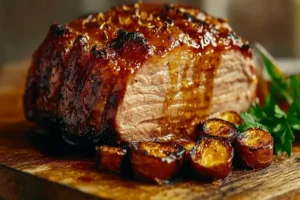
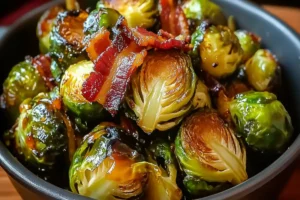

3 thoughts on “Chinese Squash Recipes: 8 Vegan Kabocha Dishes to Try”